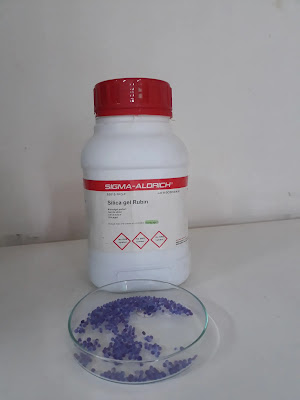Contents
hide
CHEMICAL PRODUCT IDENTIFICATION
- Product Description: Silica gel “Rubin” is a type of silica gel that is used as a desiccant or a substance that absorbs moisture. It is often used to dry gases, solids, & liquids, as well as to preserve the shelf life of various products.
- Signal Word: N/A.
- Read – Silica Gel Rubin SDS!
HAZARDS IDENTIFICATION
- As per GHS classifications for the Hazards Communication Standard, this chemical is not deemed dangerous.
- All laboratory substances should be handled with care.
- Although this substance is thought to be nonhazardous, unanticipated chemical reactions are always a possibility.
- Laboratory procedures should be followed carefully.
COMPOSITION, INFORMATION ON INGREDIENTS
- Component Name: Silica Gel.
- CAS: Number: according to mesh size.
- CAS: Numbers (All): 112926-00-8. (Silica Gel Rubin, Fluka Honeywell )
- Particle Size: 1-3 mm.
- Formula: SiO2•xH2O
- Formula Wt.: Tends to vary.
- Synonyms: Amorphous hydrated silica. (Drying bags with silica-gel Rubin)
FIRST-AID MEASURES
- If you feel unwell, contact a doctor.
- If inhaled: Remove the victim to fresh air & keep them at rest in a breathing-friendly position.
- If in the eyes: Carefully rinse for a few minutes with water. If contact lenses are present and simple to remove, do so. Rinsing continues.
- If on the skin: Thoroughly rinse with water.
- If Swallowed: Rinse mouth if swallowed. If you feel unwell, contact a doctor.
FIRE-FIGHTING MEASURES
- It is non-flammable (solid).
- Toxic gases could be released during decomposition when heated.
- Use a tri-class dry chemical fire extinguisher in the event of a fire.
ACCIDENTAL RELEASE MEASURES
- Don’t let solids fly into the air.
- Ventilate the area.
- Clean up, put in a sealed bag or container, & throw away.
- After the stuff has been picked up, clean the spill area.
HANDLING & STORAGE
- Store alongside carbonates, oxides, silicates, & hydroxides.
- The substance that is sensitive to moisture.
- Keep the container firmly shut.
- Store inside a Lab’s chemical safety bag in a cold, dry location.
EXPOSURE CONTROLS, PERSONAL PROTECTION
- Wear appropriate eye protection, gloves, & clothes.
- After handling, carefully wash your hands.
PHYSICAL & CHEMICAL PROPERTIES
- Appearance: complying. ( Fine, dry granules that are white, blue, orange, pink, & red)
- Odour: It is odourless.
- Solubility: Insoluble generally.
- Boiling point: 2230 °C.
- Melting point: 1710 °C.
- Specific gravity: 2.1.
STABILITY & REACTIVITY
- Avoid coming into contact with hydrofluoric acid or hydrogen fluoride.
- When silica gel absorbs water, the colour changes to white, signalling this.
- If kept dry, shelf life is good.
TOXICOLOGICAL INFORMATION
- Acute effect: Potential irritant.
- Chronic effect: N.A
- Target organ: N.A
- N.A. for ORL-RAT LD50.
- LC50 for IHL-RAT: N.A.
- LD50 for SKN-RBT: N.A.
ECOLOGICAL INFORMATION
- In a variety of applications, silica gel can safely & effectively control moisture levels with little negative influence on the environment.
DISPOSAL CONSIDERATIONS
- Dispose of in accordance with local, state, & federal rules or laws.
TRANSPORT INFORMATION
- Name of shipment: Unrestricted. Risk category: N/A. UN identifier: N/A.
REGULATORY INFORMATION
- Not included.
OTHER INFORMATION
This Silica Gel Rubin SDS is intended as a piece of advice & is based on data & tests that are likely to be reliable. I don’t guarantee the data’s correctness or completeness & I’m not responsible for any resulting losses. The information is only being provided for your review, research, & verification. I DO NOT ASSUME RESPONSIBILITY AND EXPRESSLY DISCLAIM LIABILITY FOR LOSS, DAMAGE OR EXPENSE RESULTING FROM OR IN ANY WAY CONNECTED WITH THE HANDLING, STORAGE, USE OR DISPOSAL OF THIS PRODUCT FOR THE FOREGOING AND OTHER REASONS.

CONCLUSION
Silica-Gel Rubin is a desiccant that is employed to preserve the shelf life of various products & to dry gases, liquids, & solids. If heated above 230 degrees Celsius, it can release harmful gases including carbon monoxide & carbon dioxide. If silica gel handling dust is inhaled, it can cause lung discomfort, coughing, & breathing difficulties. Long-term exposure to silica gel dust can induce silicosis, a lung condition brought on by the buildup of silica dust within the lungs. When handling silica gel, it’s important to wear the proper personal protective equipment, take care not to make any dust, keep the material in a cool, dry location away from heat sources & direct sunlight, & dispose of it as hazardous material in according to local, state, & federal rules. In short, One must follow the Silica Gel Rubin SDS before handling this product.
